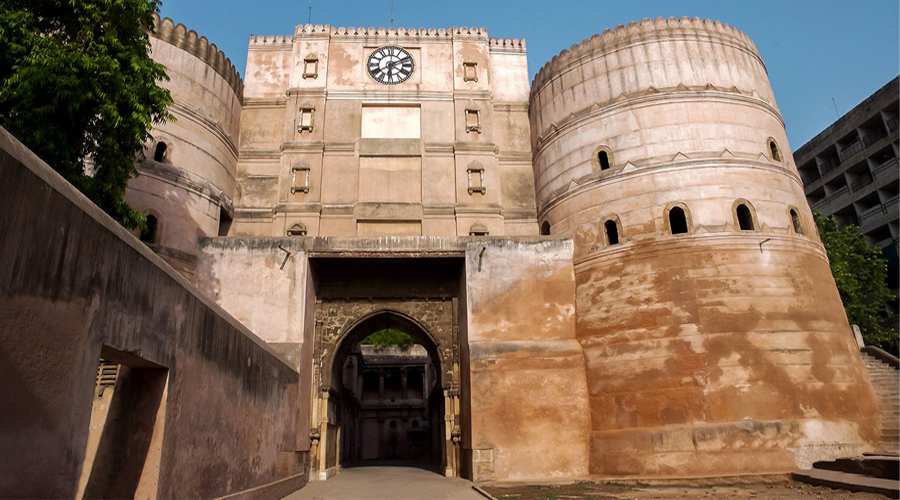Bhadra Fort, an iconic symbol at the core of Ahmedabad, Gujarat, stands as a majestic testament to the city’s rich historical and architectural heritage. Built in 1411 by Sultan Ahmed Shah I, the founder of Ahmedabad, the fort is not just a relic of the past but a living monument that encapsulates centuries of history, culture, and urban development. Sprawling over approximately 43 acres, Bhadra Fort was the nucleus of the old walled city, serving as a royal palace, administrative hub, and fortress, surrounded by imposing walls, intricate architecture, and vibrant public spaces.
Historical Background
When Sultan Ahmed Shah I decided to establish Ahmedabad as his new capital in the early 15th century, he envisioned a fortified city that was not only a political center but also a hub of culture and commerce. The cornerstone of this vision was the construction of Bhadra Fort, which began in 1411 under the supervision of Malik Sarang, a notable architect of the era. Completed by 1413, the fort was strategically built on the eastern bank of the Sabarmati River and named “Bhadra” after either the ancient Rajput citadel of the same name at Anhilwada-Patan or the Bhadra Kali temple associated with the site.
With its square shape, the fort enclosed around 162 houses and featured 14 circular towers or minars, eight gates of varying sizes, and formidable walls that safeguarded the city. The fort not only served defensive purposes but was also the royal court and residence of the rulers of the Gujarat Sultanate. Over time, the fort witnessed the rise and fall of empires, going through subsequent phases under Mughal rulers, Marathas, and the British colonial administration, each adding layers to its story and architecture.
Architectural Highlights
Bhadra Fort is a splendid example of Indo-Islamic architecture, which beautifully fuses Islamic, Persian, Hindu, and Timurid design elements into a harmonious whole. The fort’s design employs red sandstone extensively, giving its walls and structures a characteristic warm, reddish hue that stands out vividly.
Some notable architectural features include:
- The Bhadra Gate (Eastern Gate): The primary and most imposing gate faces east, known historically as Piran Pir’s Darwaza or simply Bhadra Darwaza. Flanked by intricate arches, balconies, and floral latticework, the gate stands as a grand entrance to the fortified city.
- Teen Darwaza (Triple Gateway): Located on the eastern side of the fort, this triple-arched gateway was historically an entrance to the royal square known as Maidan-Shah. Its imposing design and detailed carvings make it one of Ahmedabad’s most recognized landmarks.
- Lal Darwaza and Ganesh Bari Gates: On the north and southwest sides, respectively, these gates each contribute to the fort’s defensive and aesthetic layout. Though partly ruined, their remnants give a glimpse into the fort’s lost grandeur.
- Ornate Palaces and Mosques: Inside the fort, visitors can explore royal palaces with intricately carved balconies and the Ahmed Shah’s Mosque—one of the oldest mosques in Ahmedabad, showcasing fine Islamic calligraphy and symmetrical architecture.
- Nagina Baugh (The Royal Garden): Within the fort complex was a lush garden with irrigated green spaces designed for royal leisure, featuring water channels and fountains that speak of sophisticated urban planning.
- Walls and Bastions: The fort’s walls were studded with 14 minars (towers) and bastions, designed both for aesthetic appeal and military defense, reflecting advanced fortification techniques of the time.
The fort walls were not just military structures but also served as a vibrant backdrop for ceremonies, processions, and royal functions, making Bhadra Fort a center of both power and culture.
Historical and Cultural Significance
Bhadra Fort was the epicenter of Ahmedabad’s political and cultural life for centuries. During the Gujarat Sultanate period, it housed the royal family, court officials, and the administrative apparatus. The fort witnessed historical events such as battles, governance changes, and social reforms.
When the Mughal emperor Akbar conquered Ahmedabad in the late 16th century, the fort continued to be used as a residence for governors and military commanders. Later, in the 17th century, the Mughal governor Azam Khan built a Sarai (resting place for travelers) within the fort, known as Azam Khan Sarai, contributing to its architectural diversity.
During British colonial rule, parts of the fort were repurposed as government offices and a jail, marking a transformation from royal grandeur to colonial administration. The surrounding areas, once palace neighborhoods, gradually developed into urban markets and civic spaces, with iconic sites like Manek Chowk and the historic Bhadra Kali temple in close proximity.
Today, Bhadra Fort stands as a cultural landmark designated for preservation and adaptive reuse by the Ahmedabad Municipal Corporation and the Archaeological Survey of India. The fort underwent extensive renovation in 2014, including restoration of the gate, walls, and open areas, earning it a new identity as a cultural and heritage center where festivals, exhibitions, and city events take place regularly.
Visitor Experience and Surroundings
Bhadra Fort’s location in the old walled city area makes it easily accessible and a favorite spot for history enthusiasts and tourists exploring Ahmedabad’s heritage.
Visitors can enter through the impressive imposing gates and explore open courtyards, the royal palace areas, and Jami Masjid (Ahmed Shah’s mosque). The fort’s rooftop offers panoramic views of the bustling old city with its narrow lanes and colorful markets, providing a glimpse into the vibrant life that has surrounded the fort for centuries.
Adjacent landmarks such as the Meena Bazaar, Manek Chowk, and the Bhadra Kali Temple augment the cultural experience, creating a holistic historic precinct. The Maidan-Shah area near the Triple Gateway was historically a royal ground for games and public gatherings and continues to serve as a public space.
The fort provides a mix of calm, reflective heritage spaces alongside the lively pulse of the urban surroundings, symbolizing the coexistence of old and new Ahmedabad.
Preservation and Cultural Role
Bhadra Fort’s preservation is critical to Ahmedabad’s identity as a city proud of its heritage. Its restoration has revitalized interest in the city’s medieval past and provides a venue for cultural performances and public events. The fort hosts traditional festivals, government ceremonies, and occasionally serves as a stage for theatrical and musical presentations, linking contemporary culture with tradition.
Its walls and structures stand not only as relics of sandstone and mortar but as storytellers of centuries of governance, community life, and architectural innovation. The fort’s conservation also reflects broader initiatives in India to safeguard historical monuments that define local and national histories.
Conclusion
The Bhadra Fort of Ahmedabad is far more than an ancient defensive structure; it is a living symbol of the city’s founding spirit, resilience, and cultural richness. With its mix of royal palaces, gateways, mosques, gardens, and strong fortifications, the fort captures the essence of medieval Indo-Islamic architecture and urban planning.
From Sultan Ahmed Shah I’s vision in the early 1400s to its current status as a vibrant cultural hub, Bhadra Fort continues to invite visitors on a journey through time, reflecting Ahmedabad’s evolution as a historic, dynamic metropolis.
Exploring Bhadra Fort offers a compelling mix of architectural grandeur, historic memory, and cultural experience — a must-see for anyone seeking to understand the soul of Ahmedabad and the legacy of its royal past.


